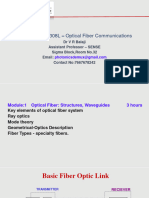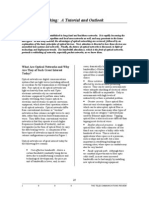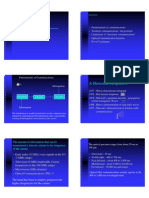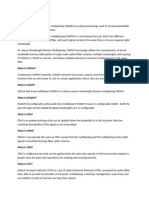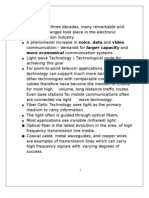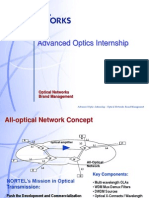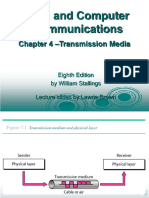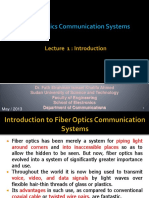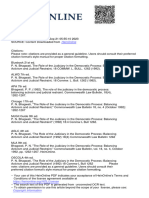Introduction To OFC Technology 1
Uploaded by
Akash PatelIntroduction To OFC Technology 1
Uploaded by
Akash PatelIntroduction to
OPTICAL FIBER TECHNOLOGY
OBJECTIVES
1. What is Fiber Optic Technology?
2. Why Fiber Optic Technology?
3. How Optical Transmission fulfills the need?
4. Why Optical Fibers?
5. Present & Future OFC- Systems
General Communication Link
• Information Source: provide electrical signal, usually derived from a
massage signal which is not electrical (sound, data)- Analog/digital
• Transmitter : Comprises of electronic components - convert the signal into
suitable form for propagation over the transmission medium- often achieved by
modulating the carrier.
• Transmission Medium: A pair of wires, coaxial cable or a radio link
through free space down which signal is transmitted to the receiver - channel.
• Receiver: Signal is transformed into original electrical signal (demodulation)
before being passed onto the destination.
What is Fiber Optic Technology?
* Also called Lightwave Technology
• Fiber Optic Technology uses light
as the primary medium to carry
information.
• The light often is guided through
optical fibers.
• Most applications use invisible
(infrared) light.
Optical Fiber Communication System
At the transmitter section, the electrical signal is converted into an optical
signal using an optical source (intensity modulation).
The modulated optical signal is transmitted through optical fibers to the
receiver.
At the receiver end, the optical signal is reconverted to the electrical signal
for further processing (demodulation) before passing onto destination.
Importance Fiber Optic Technology?
During past three decades, many remarkable and dramatic
changes took place in the electronic communication industry
over the Globe..
• A phenomenal increase in voice, data and video
communication - demands for larger capacity and more
economical communication systems.
• Lightwave Technology: Technological route for
achieving this goal
. Most cost-effective way to move huge amounts of
information (voice, video, data) quickly and reliably.
The Electromagnetic Spectrum
How Optical Transmission fulfill the need?
For good communication a system needs to have following things.
(1) Bandwidh (BW)
(2) Good signal to noise ratio (SNR) i.e. low loss
Since the bandwidth of a system is more or less proportional to the frequency of operation,
use of higher frequency facilitates larger BW.
Wider the bandwidth, the greater its information carrying capacity.
The information carrying capacity of a communications system is
directly proportional to its bandwidth;
The BW at optical frequencies is expected to be 3 to 4 orders of magnitude higher than
that at the microwave f requencies (1GHz to 100GHz).
A system with light as carriers has an excessive bandwidth (more than
100,000 times than achieved with microwave frequencies)
Communication Channel Capacity
Communication Carrier Bandwidth 2 way voice
Medium Frequency Channels
Copper Cable 1 MHz 100 kHz < 2000
Coaxial Cable 100 MHz 10 MHz 13,000
Optical Fiber 100 –1000 THz 40 THz >3,00,000 or
Advantages of Optical Fiber
Wide Bandwidth: Extremely high information carrying
capacity (~GHz)
3,00,000 voice channels on a pair of fiber
Voice/Data/Video Integrated Service
2.5 Gb/s systems from NTT ,Japan; 5 Gb/s System Siemens
Low loss : Information can be sent over a large distance.
Losses ~ 0.2 dB/km
Repeater spacing >100 km with bit rates in Gb/s
Interference Free
Immune to Electromagnetic interference: No cross talk between fibers
Can be used in harsh or noisy environments
Higher security : No radiations, Difficult to tap
Attractive for Defense, Intelligence and Banks Networks
Advantages of Optical Fiber: Contd..
Compact & light weight
Smaller size : Fiber thinner than human hair
Can easily replace 1000 pair copper cable of 10 cm dia.
Fiber weighs 28gm/km; considerably lighter than copper
Light weight cable
Environmental Immunity/Greater safety
Dielectric- No current, No short circuits – Extremely safe for
hazardous environments; attractive for oil & petrochemicals
Not prone to lightning
Wide temperature range
Long life > 25 years
Abundant Raw Material : optical fibers made from Sand
Not a scarce resource in comparison to copper.
Some Practical Disadvantages
Optical fibers are relatively expensive.
Connectors very expensive: Due to high degree of precision
involved
Connector installation is time consuming and highly skilled
operation
Jointing (Splicing) of fibers requires expensive equipment
and skilled operators
Connector and joints are relatively lossy.
Difficult to tap in and out ( for bus architectures)- need
expensive couplers
Relatively careful handling required
WAVELENGTHS OF OPERATION
Attenuation in Silica Fibers
Attenuation (dB/ km )
2.5
2 3 “ Optical
2.0 Windows”
1
1.5
1.0
0.5
900 1100 1300 1500 1700
Wavelength (nm )
850 nm 1310 nm 1550 nm
OFC- Systems
Currently installed Systems: operating at 1310 nm window
• Low loss; minimum pulse broadening
• Transmission rate 2-10 Gb/s
• Regeneration of Signal after every 30-60 km
Conversion of O-E-O signal
Future OFC Systems: 1550 nm band
• Silica has lowest loss, increased dispersion
Design of Dispersion Shifted Fibers
Lowest loss and Negligible dispersion
Erbium Doped Fiber Amplifier
Direct amplification of optical signal
Flat gain around 1550nm low loss window
BW 12,500 GHz ; Enormous potential
WDM/DWDM Concept
Typical WDM network containing various types of optical amplifiers.
Future OFC- Systems
Coincidence of low-loss window & wide-BW EDFA
Possibilities of WDM Communication Systems
Soliton pulse transmission
Capable of carrying enormous rates of information
Examples:
• 1.1 Tb/s over 150 km ; 55 wavelengths WDM
• 2.6 Tb/s over 120 km ; 132 wavelengths WDM
Optical Network System
Transmitters Receivers
Optical Layers Optical Multiplexing Section Layer (OMS-L)
l Optical Transmission Section Layer (OTS-L) l
Add/Drop
l l
DEMUX
MUX
EDFA EDFA EDFA
ln li li ln
Router
Metropolitan-Access Network
Network Management Layer
Digital Client Layer Optical Channel (OC-N) Layer
Digital Client Layer SONET/SDH/PDH/ATM/ IP/etc. Digital Hierarchy Layer
EDFA = Erbium-doped fiber amplifier
MUX = Multiplexer
DEMUX = Demultiplexer
Bands in Light Spectrum
Approximate Attenuation
of Single Mode fiber cable
Visible Infrared
700 900 1100 1300 1500 1700 nm
“O” Band ~ 1270-1350 nm
“E” Band ~ 1370 - 1440 nm
“S” Band ~ 1470 - 1500 nm
“C” Band ~ 1530 - 1565 nm
“L” Band ~ 1570 - 1610 nm
FORESIGHT…
Lightwave Communication Systems Employing Rare
Earth Doped Fibers and Soliton Pulses
“ZERO LOSS & NEAR INFINITE BANDWIDTH “
Fiber Optics- Market Potential in India
Fiber Optics market potential in India.
Fifty Years of Fiber Optics
THANK YOU
You might also like
- A. Lecture - Introduction Optical Fiber Communication.No ratings yetA. Lecture - Introduction Optical Fiber Communication.57 pages
- Opticalnetworking 150209044547 Conversion Gate02No ratings yetOpticalnetworking 150209044547 Conversion Gate0255 pages
- Fiber Optic Telecommunication: I. B F ONo ratings yetFiber Optic Telecommunication: I. B F O18 pages
- Fiber-Optic Communication Systems An Introduction: Pablo A. Costanzo CasoNo ratings yetFiber-Optic Communication Systems An Introduction: Pablo A. Costanzo Caso36 pages
- Fiber Optics Communication Systems: Lecture 1: IntroductionNo ratings yetFiber Optics Communication Systems: Lecture 1: Introduction28 pages
- Fiber-Optic Communication Systems An Introduction: Xavier Fernando Ryerson UniversityNo ratings yetFiber-Optic Communication Systems An Introduction: Xavier Fernando Ryerson University36 pages
- Optical Networking: A Tutorial and Outlook: What Are Optical Networks and Why Are They of Such Great Interest Today?No ratings yetOptical Networking: A Tutorial and Outlook: What Are Optical Networks and Why Are They of Such Great Interest Today?19 pages
- Introduction To Optical Networking: From Wavelength Division Multiplexing To Passive Optical NetworkingNo ratings yetIntroduction To Optical Networking: From Wavelength Division Multiplexing To Passive Optical Networking39 pages
- WINSEM2024-25 BECE318L TH CH2024250500924 Reference Material I 14-12-2024 1-Evolution of Optical CommunicationNo ratings yetWINSEM2024-25 BECE318L TH CH2024250500924 Reference Material I 14-12-2024 1-Evolution of Optical Communication58 pages
- A Historical Perspective: Overview of Optical Fiber CommunicationsNo ratings yetA Historical Perspective: Overview of Optical Fiber Communications5 pages
- Introduction To Optical Networking: From Wavelength Division Multiplexing To Passive Optical NetworkingNo ratings yetIntroduction To Optical Networking: From Wavelength Division Multiplexing To Passive Optical Networking39 pages
- More Economical Communication Systems.: Achieving This GoalNo ratings yetMore Economical Communication Systems.: Achieving This Goal24 pages
- Data and Computer Communications: Chapter 4 - Transmission MediaNo ratings yetData and Computer Communications: Chapter 4 - Transmission Media35 pages
- Chapter 1_Introduction to Fiber Optic CommunicationNo ratings yetChapter 1_Introduction to Fiber Optic Communication25 pages
- Introduction To Optical Fiber CommunicationNo ratings yetIntroduction To Optical Fiber Communication18 pages
- Advanced Optics Internship: Optical Networks Brand ManagementNo ratings yetAdvanced Optics Internship: Optical Networks Brand Management46 pages
- Introduction To Optical Networks: Dept of Telecommunication Atria Institute of TechnologyNo ratings yetIntroduction To Optical Networks: Dept of Telecommunication Atria Institute of Technology21 pages
- Data and Computer Communications: - Transmission MediaNo ratings yetData and Computer Communications: - Transmission Media39 pages
- DLL 4Q MAPEH G8 Basic Steps in Folk Dancing100% (1)DLL 4Q MAPEH G8 Basic Steps in Folk Dancing2 pages
- Part II: A Stakeholder Perspective Chapter 3: Stakeholder TheoryNo ratings yetPart II: A Stakeholder Perspective Chapter 3: Stakeholder Theory17 pages
- Server Room Temperature Humidity MonitorNo ratings yetServer Room Temperature Humidity Monitor9 pages
- A Mix Design Procedure For Geopolymer Concrete WitNo ratings yetA Mix Design Procedure For Geopolymer Concrete Wit9 pages
- Template Marine Contractor Office Audit QuestionnaireNo ratings yetTemplate Marine Contractor Office Audit Questionnaire16 pages
- Balancing Activism & Restraint Jus. P.N. BhagwatiNo ratings yetBalancing Activism & Restraint Jus. P.N. Bhagwati7 pages
- Hotel Portfolio by Sapa Building System - ENNo ratings yetHotel Portfolio by Sapa Building System - EN23 pages
- Course Outline: International Islamic University MalaysiaNo ratings yetCourse Outline: International Islamic University Malaysia6 pages
- 3 Level Authentication - TutorialsDuniyaNo ratings yet3 Level Authentication - TutorialsDuniya50 pages
- A. Lecture - Introduction Optical Fiber Communication.A. Lecture - Introduction Optical Fiber Communication.
- Fiber-Optic Communication Systems An Introduction: Pablo A. Costanzo CasoFiber-Optic Communication Systems An Introduction: Pablo A. Costanzo Caso
- Fiber Optics Communication Systems: Lecture 1: IntroductionFiber Optics Communication Systems: Lecture 1: Introduction
- Fiber-Optic Communication Systems An Introduction: Xavier Fernando Ryerson UniversityFiber-Optic Communication Systems An Introduction: Xavier Fernando Ryerson University
- Optical Networking: A Tutorial and Outlook: What Are Optical Networks and Why Are They of Such Great Interest Today?Optical Networking: A Tutorial and Outlook: What Are Optical Networks and Why Are They of Such Great Interest Today?
- Introduction To Optical Networking: From Wavelength Division Multiplexing To Passive Optical NetworkingIntroduction To Optical Networking: From Wavelength Division Multiplexing To Passive Optical Networking
- WINSEM2024-25 BECE318L TH CH2024250500924 Reference Material I 14-12-2024 1-Evolution of Optical CommunicationWINSEM2024-25 BECE318L TH CH2024250500924 Reference Material I 14-12-2024 1-Evolution of Optical Communication
- A Historical Perspective: Overview of Optical Fiber CommunicationsA Historical Perspective: Overview of Optical Fiber Communications
- Introduction To Optical Networking: From Wavelength Division Multiplexing To Passive Optical NetworkingIntroduction To Optical Networking: From Wavelength Division Multiplexing To Passive Optical Networking
- More Economical Communication Systems.: Achieving This GoalMore Economical Communication Systems.: Achieving This Goal
- Data and Computer Communications: Chapter 4 - Transmission MediaData and Computer Communications: Chapter 4 - Transmission Media
- Chapter 1_Introduction to Fiber Optic CommunicationChapter 1_Introduction to Fiber Optic Communication
- Advanced Optics Internship: Optical Networks Brand ManagementAdvanced Optics Internship: Optical Networks Brand Management
- Introduction To Optical Networks: Dept of Telecommunication Atria Institute of TechnologyIntroduction To Optical Networks: Dept of Telecommunication Atria Institute of Technology
- Data and Computer Communications: - Transmission MediaData and Computer Communications: - Transmission Media
- Learn Amateur Radio Electronics on Your SmartphoneFrom EverandLearn Amateur Radio Electronics on Your Smartphone
- Part II: A Stakeholder Perspective Chapter 3: Stakeholder TheoryPart II: A Stakeholder Perspective Chapter 3: Stakeholder Theory
- A Mix Design Procedure For Geopolymer Concrete WitA Mix Design Procedure For Geopolymer Concrete Wit
- Template Marine Contractor Office Audit QuestionnaireTemplate Marine Contractor Office Audit Questionnaire
- Course Outline: International Islamic University MalaysiaCourse Outline: International Islamic University Malaysia


















